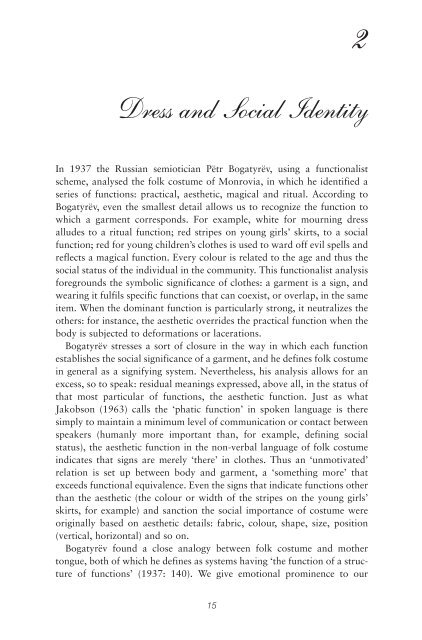You also want an ePaper? Increase the reach of your titles
YUMPU automatically turns print PDFs into web optimized ePapers that Google loves.
Dress and Social Identity<br />
In 1937 the Russian semiotician Pëtr Bogatyrëv, using a functionalist<br />
scheme, analysed the folk costume of Monrovia, in which he identified a<br />
series of functions: practical, aesthetic, magical and ritual. According to<br />
Bogatyrëv, even the smallest detail allows us to recognize the function to<br />
which a garment corresponds. For example, white for mourning dress<br />
alludes to a ritual function; red stripes on young girls’ skirts, to a social<br />
function; red for young children’s clothes is used to ward off evil spells and<br />
reflects a magical function. Every colour is related to the age and thus the<br />
social status of the individual in the community. This functionalist analysis<br />
foregrounds the symbolic significance of clothes: a garment is a sign, and<br />
wearing it fulfils specific functions that can coexist, or overlap, in the same<br />
item. When the dominant function is particularly strong, it neutralizes the<br />
others: for instance, the aesthetic overrides the practical function when the<br />
body is subjected to deformations or lacerations.<br />
Bogatyrëv stresses a sort of closure in the way in which each function<br />
establishes the social significance of a garment, and he defines folk costume<br />
in general as a signifying system. Nevertheless, his analysis allows for an<br />
excess, so to speak: residual meanings expressed, above all, in the status of<br />
that most particular of functions, the aesthetic function. Just as what<br />
Jakobson (1963) calls the ‘phatic function’ in spoken language is there<br />
simply to maintain a minimum level of communication or contact between<br />
speakers (humanly more important than, for example, defining social<br />
status), the aesthetic function in the non-verbal language of folk costume<br />
indicates that signs are merely ‘there’ in clothes. Thus an ‘unmotivated’<br />
relation is set up between body and garment, a ‘something more’ that<br />
exceeds functional equivalence. Even the signs that indicate functions other<br />
than the aesthetic (the colour or width of the stripes on the young girls’<br />
skirts, for example) and sanction the social importance of costume were<br />
originally based on aesthetic details: fabric, colour, shape, size, position<br />
(vertical, horizontal) and so on.<br />
Bogatyrëv found a close analogy between folk costume and mother<br />
tongue, both of which he defines as systems having ‘the function of a structure<br />
of functions’ (1937: 140). We give emotional prominence to our<br />
15<br />
2

















